8 Open-Source ChatGPT Alternatives for 2026
Since its launch in 2022, ChatGPT has transformed huge aspects of our daily lives, including in the context of business processes.
However, at a practical level, many organizations still struggle to implement AI tools in a way that drives real value. Part of the issue here is that, while hugely powerful, ChatGPT isn’t always the exact right fit for the needs of large, security-conscious organizations.
Today, we’re exploring one important element of this by checking out the market for open-source ChatGPT alternatives.
Specifically, we’ll be covering:
- What is ChatGPT?
- Why would you want an open-source ChatGPT alternative?
- What to look for in an open-source ChatGPT alternative
- 8 open-source ChatGPT alternatives for 2026
Let’s start with the basics.
What is ChatGPT?
ChatGPT probably doesn’t need much introduction. It’s OpenAI’s flagship AI chat tool. This is not to be confused with the underlying language models that power it, which are currently on the GPT-5 family of LLMs.
It’s built around a conversational interface, which enables users to submit queries and questions via natural language prompts. The model then interprets these before generating responses based on its training data, as well as web-based sources.
Because of this, it has quickly become a ubiquitous part of how users interact with information online, including taking a large slice of usage away from traditional search.
In a professional context, huge numbers of workers also use ChatGPT’s generative capabilities for tasks such as drafting copy, editing emails, writing code, and more. ChatGPT’s more advanced models can even generate images and videos.
Many teams also leverage ChatGPT as part of their workflow automation efforts. This can come in a few different configurations.
One is utilizing Custom GPTs, which are essentially versions of ChatGPT that can be tweaked and customized with specific knowledge, instructions, and capabilities.
Another is utilizing ChatGPT via API connections. This enables us to use ChatGPT within structured workflow automations in a consistent, rules-based manner. For instance, making a call to OpenAI’s API to perform a specific function within a wider workflow.
Recently, OpenAI also introduced ChatKit, which enables teams to build agentic experiences within ChatGPT, including leveraging tool use and embedded UI components within chats.
Alternatively, many AI tools within use-case-specific business platforms are themselves powered by ChatGPT.
For example, ticketing bots within many ITSM platforms.
To support business usage, ChatGPT also offers a range of capabilities for enterprise users, including SSO, data encryption, domain verification, admin tools, and preventing company data from being used in model training.
You might also like our in-depth guide to implementing a chat UI .
Why would you want an open-source ChatGPT alternative?
However, as we hinted at earlier, many large organizations have additional requirements that might preclude them from using ChatGPT internally - especially around how they store, process, and control data.
At the same time, IT teams in these kinds of companies are under pressure to provide similar capabilities to their colleagues, often due to widespread usage of ChatGPT outside of IT’s governance and control.
For these kinds of teams, open-source ChatGPT alternatives offer a clear path forward.
One of the key issues here is controlling how and where data is stored.
ChatGPT offers enterprise users the option to prevent their data from being used to train models, but many teams need to go further than this by utilizing open-source models that can be hosted on their own infrastructure.
This is especially important if the chat tool we implement is going to interact with mission critical data, which already has tight hosting requirements.
Additionally, there are several key operational reasons that we might prioritize an open-source ChatGPT alternative.
One is that these kinds of platforms often offer a high level of configuration, enabling us to closely tailor our solution to our specific requirements in terms of existing workflows.
On top of this, there are commercial factors, such as ongoing cost management and the need to avoid vendor lock-in.
To learn more about which models we might utilize, check out our guide to open-source LLMs .
What to look for in an open-source ChatGPT alternative
Understanding why we might prioritize open-source options, we can next move on to thinking about the specific decision points we’re likely to encounter when choosing a specific platform.
Firstly, it’s important to note that these types of solutions don’t always take the form of off-the-shelf, ready-to-use tools in the way that ChatGPT itself or COTS alternatives do.
Instead, we can think about these in two broad clusters:
- Chat and agent frameworks - developer-oriented toolkits and libraries, offering reusable elements to help teams build custom solutions.
- Modular chat platforms - offering pre-built solutions for some elements of our chat experience, while still retaining configurability. For instance, a ready-to-use chat UI and integration layer that we can connect our own model and tools to.
However, rather than being a clear distinction, specific platforms often exist on a spectrum between these two clusters.
Therefore, it’s still vital to understand the underlying decision points that could sway us towards one option or another.
Perhaps the biggest thing here is balancing the extent of customization available with how quickly and easily we can output a working solution. For instance, can we build our internal chatbot with visual tools, or will we require extensive development skills?
On top of this, we’ll likely want to consider:
- Security and governance - The ability to enforce authentication, RBAC, encryption, and data residency controls.
- Integration depth - How easily the platform connects with APIs, automation tools, and data stores.
- Customization and extensibility - The extent to which we can modify prompts, logic, and connected tools.
- Ease of implementation - How quickly a viable chatbot can be deployed.
- Scalability and performance - How well the system handles concurrency, data load, and latency.
- Community maturity and support - The activity level of contributors, plugin ecosystems, and documentation quality.
- Operational cost - Infrastructure, maintenance, and personnel overheads relative to equivalent commercial solutions.
- Enterprise pricing - While open-source solutions can be used for free, most platforms also charge for support and services, as well as certain premium features that we’ll need for enterprise usage.
Importantly, there’s no one-size-fits-all approach here.
Instead, in order to effectively vet and assess our options, we’ll need to have a clear idea of how each of these factors plays into our own specific requirements, in order to choose the most appropriate open-source ChatGPT alternative for our needs.
8 open-source ChatGPT alternatives for 2026
With a good grasp of why we might opt for an open-source alternative to ChatGPT, some of the specific forms that solutions can take, and the key decisions we’ll need to make when weighing up our options, we can move on to checking out our options on the market today.
As we noted earlier, there’s a fair amount of variation in the platforms we could choose. To reflect this, we’ve chosen a range of options that reflect various corners of this space.
In no particular order, these are:
Let’s check each one out in turn.
1. LibreChat
First up, we have LibreChat. This is one of the best-known open-source AI chat platforms, offering a huge amount of customization alongside support for a range of LLMs from major providers.
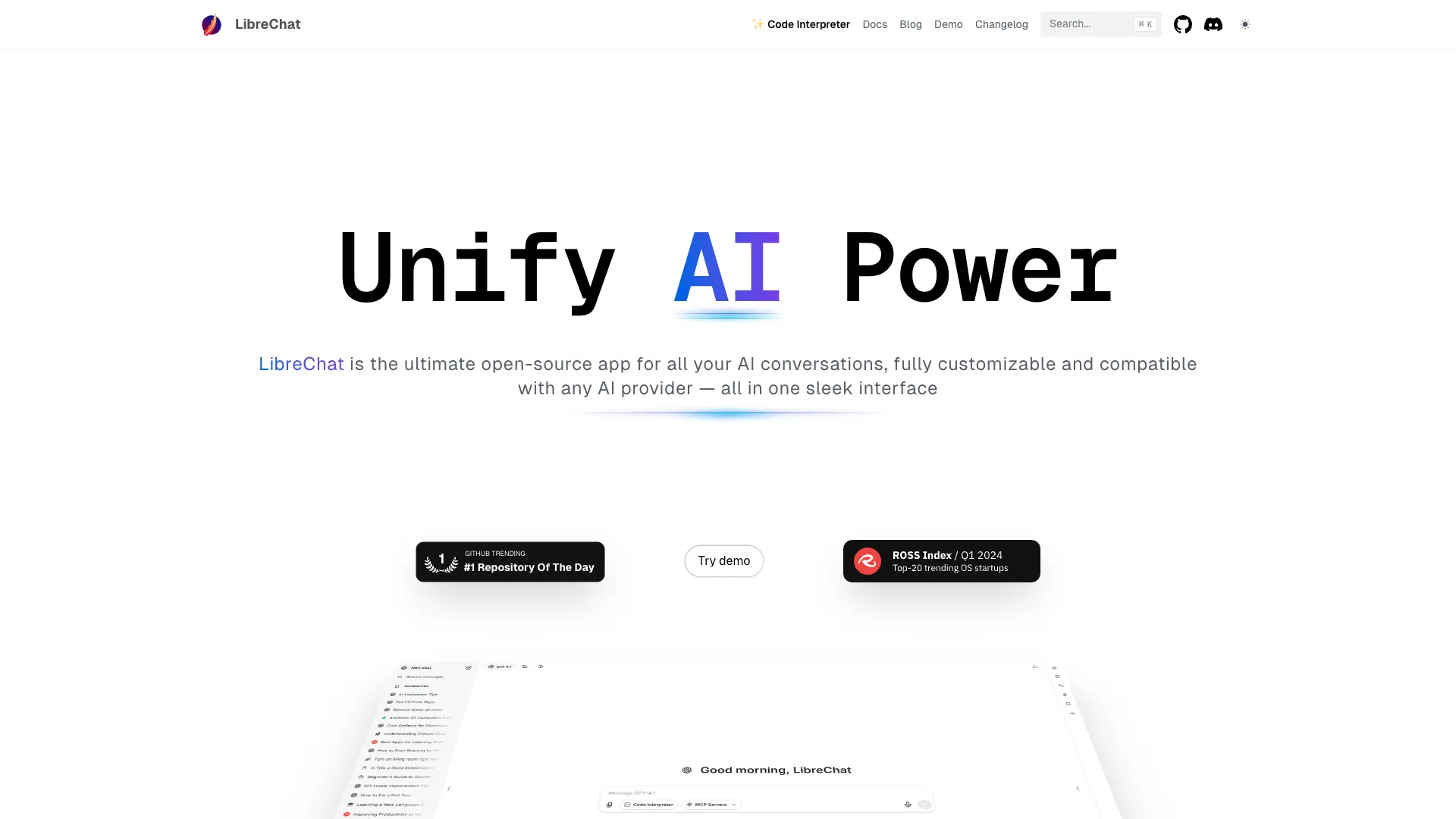
(LibreChat Website)
This centers around a pre-built chat UI that will look and feel very familiar to anyone who has used ChatGPT before. This provides a clean, intuitive chat experience out of the box, including multi-modal support, including more advanced capabilities like file handling and image analysis.
One of LibreChat’s greatest strengths is providing a ready-to-use UI that still offers huge extensibility, including custom presets, a range of configuration options, and support for custom tools and plug-ins.
LibreChat also offers a lot of flexibility for connecting to models. On top of connections to well-known COTS and open-source LLMs such as OpenAI, Azure, Mistral, Deepseek, and more, we can configure our own custom endpoints to connect to any OpenAI API-compatible model.
Additionally, LibreChat offers a range of capabilities for more advanced internal chatbot solutions, MCP support, web search, a code interpreter, and React, HTML, or diagram generation in-chat.
This makes it a great option for teams that want to build effective internal chat tools without spending extensive time building UIs from scratch.
2. LangChain
Next, we have perhaps the best-known AI framework, LangChain. As such, this is a developer-focused toolkit, aimed at enabling engineers who need to expedite the process of creating custom tools on top of LLMs.
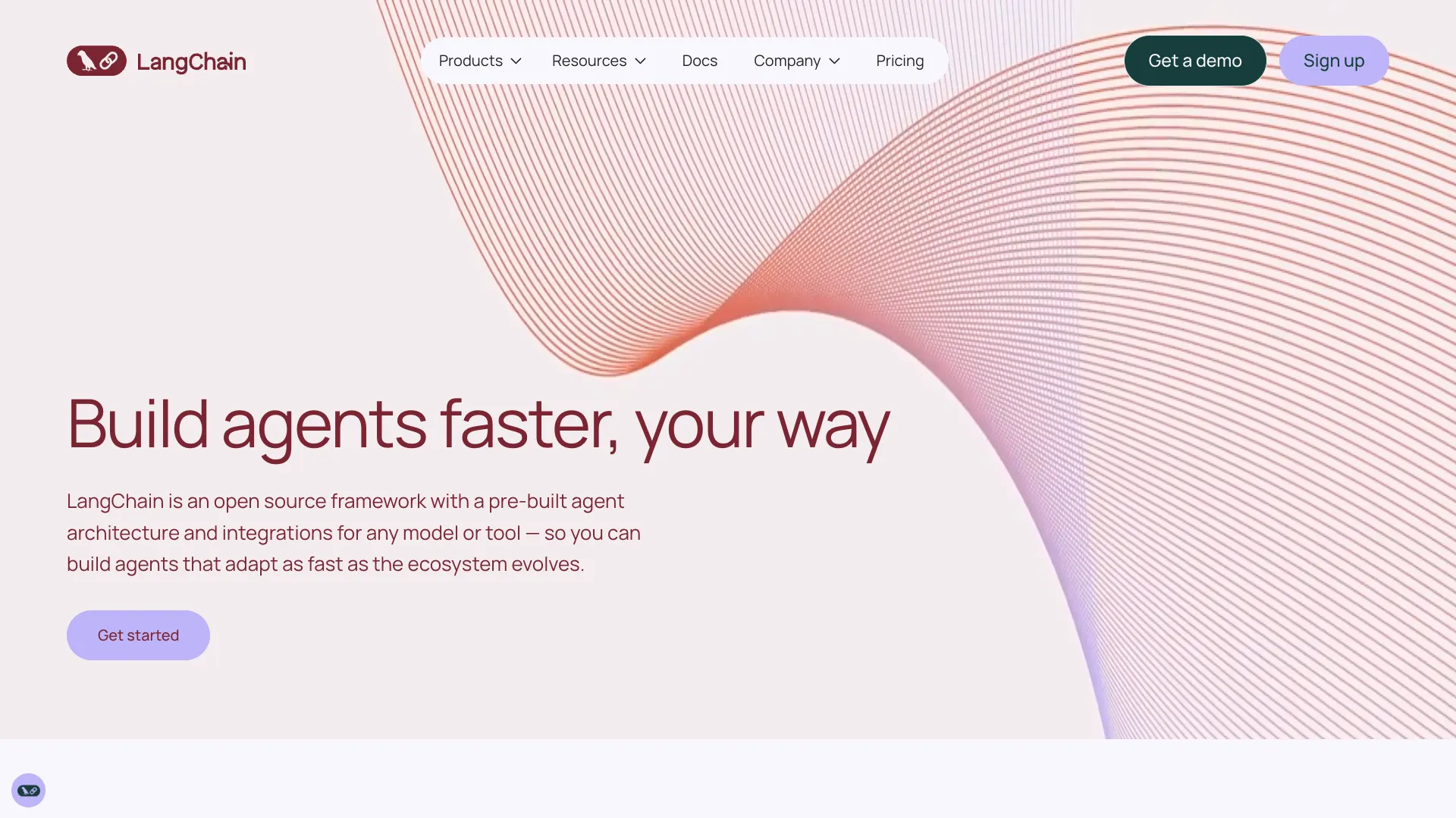
(LangChain Website)
Part of a wider ecosystem of tools, the LangChain framework itself offers a pre-built agent architecture to enable us to integrate tools and models.
As such, it offers developers an exceptional level of flexibility to craft custom solutions that we can scale and modify as our needs evolve, without having to rewrite core code.
Essentially, this provides developers with a foundation for building AI-powered systems, including chatbots, conversational assistance, and knowledge retrieval tools, by abstracting away the complexity of connecting LLMs to tools, data sources, and APIs.
Other elements of the LangChain ecosystem include the LangGraph framework for building agentic workflow systems and the LangSmith platform, which offers evaluation, observability, and deployment tools for production systems.
Overall, LangChain is a highly effective option for teams that need to build custom AI-powered solutions. But, it’s worth noting that this requires sufficient development skills and resources, so we might need to look elsewhere for open-source ChatGPT alternatives with more straightforward implementations.
3. H2oGPT
H2oGPT is a comprehensive open-source platform aimed at teams that want to build custom GPTs for offline usage.
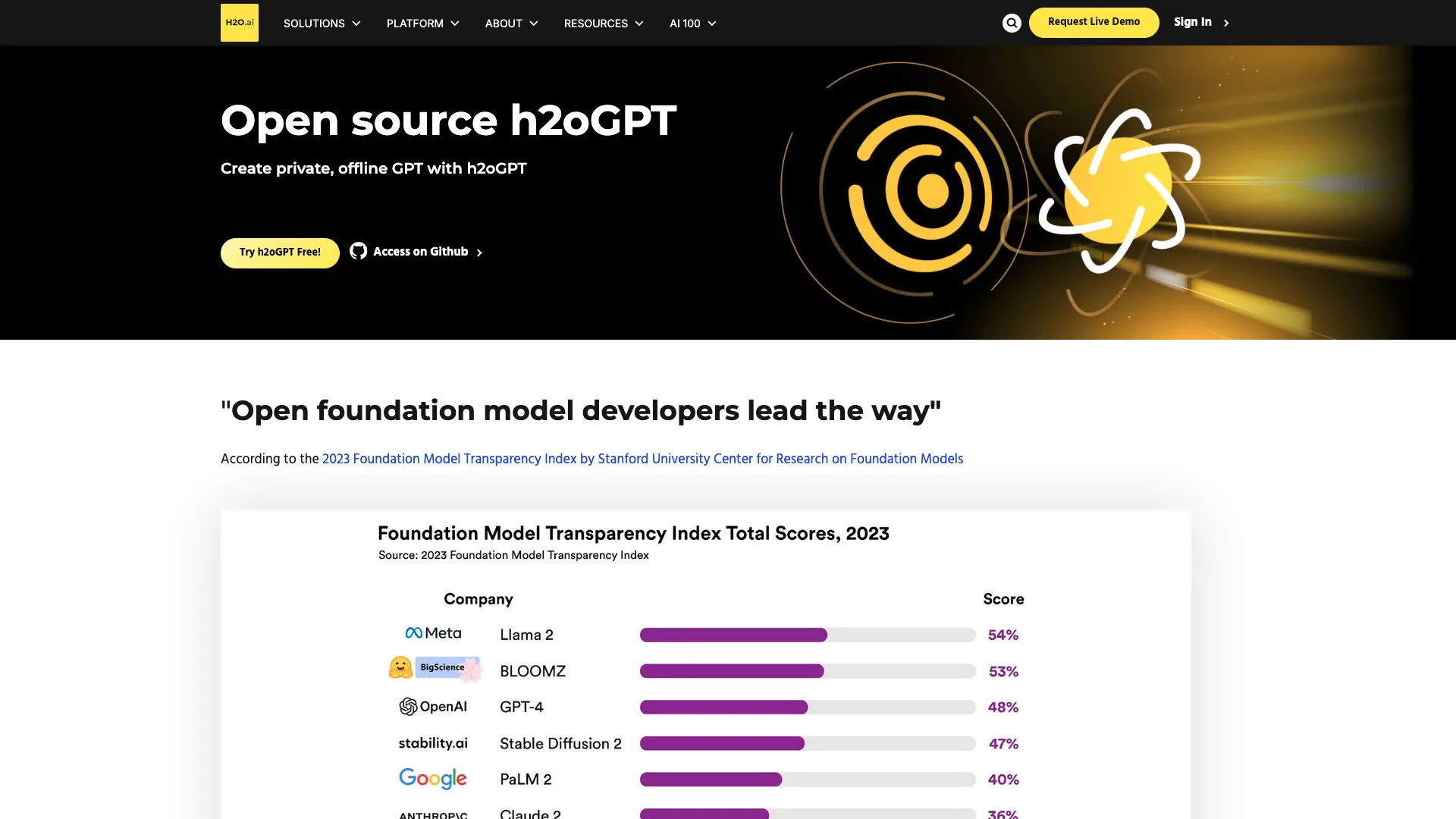
(H2oGPT Website)
The goal is to enable teams to build tools on top of local LLMs, taking advantage of the power of AI, without sacrificing control over their data.
This is available as an installable package, containing a default LLM, an embedding model and database, CLI tools, and a GUI. We also have the option of using H2oGPT as a back-end alongside Open Web UI, offering more custom, modular solutions that we can run locally.
H2oGPT also offers support for a wide range of open-source LLMs and SLMs, including LlaMa, Mistral, Falcon, and more, alongside prompt engineering and evaluation tools to help us compare model performance and choose the right one for our specific needs.
There’s also an enterprise version of the platform, H2oGPTe, offering additional features for use in large organizations, including customizable guardrails, a coding assistant, and tools for creating advanced agentic systems.
Additionally, the wider H2O ecosystem contains a variety of tools for more in-depth customization, including H2O LLM Studio, a no-code solution for training, distilling, and fine-tuning custom models.
4. Botpress
Billing itself as an all-in-one platform for building AI agents, Botpress is one of the most ubiquitous names in the market for teams seeking out an open-source ChatGPT alternative.
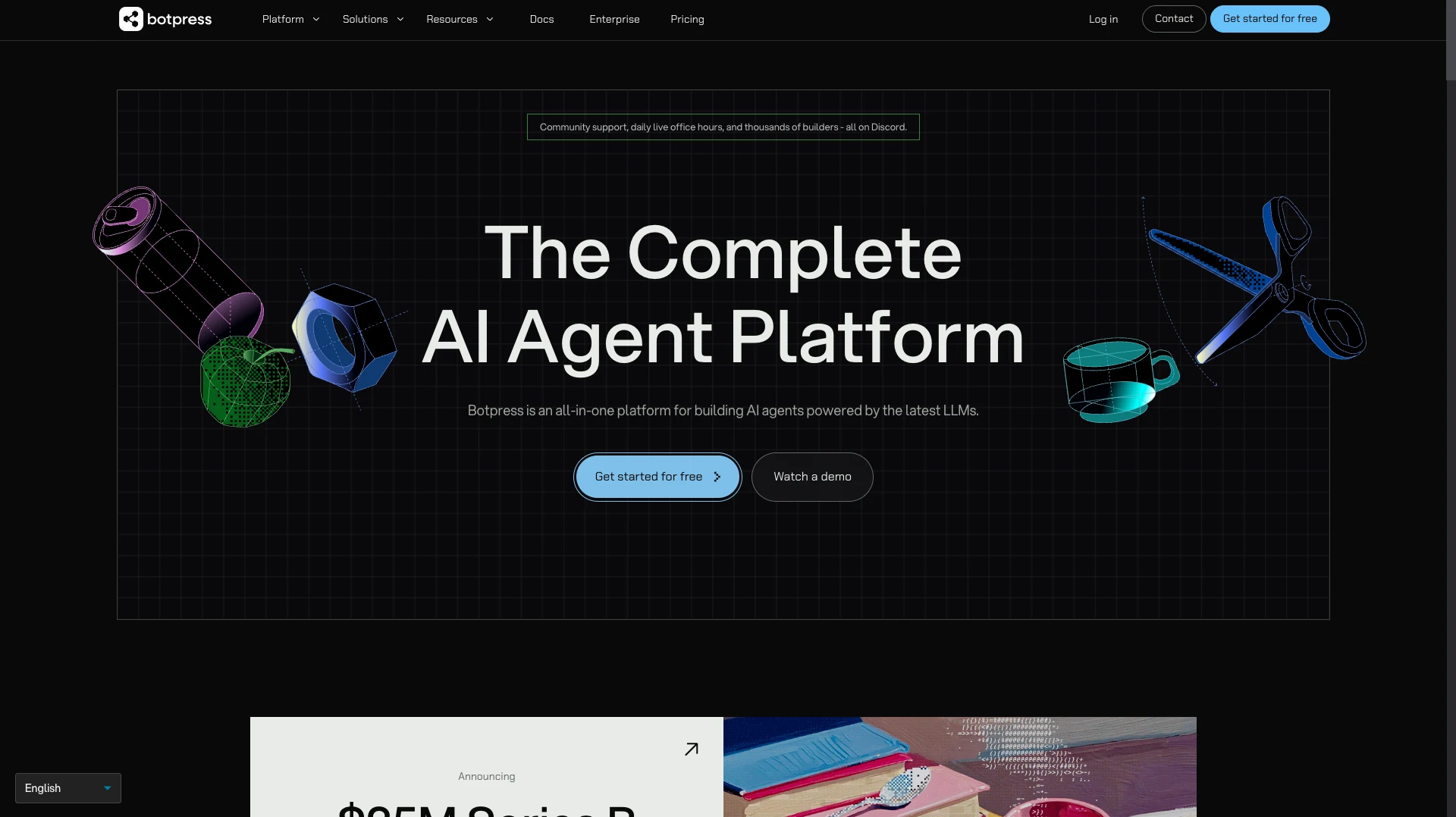
(Botpress Website)
We can think of this as a low-code platform that provides the core capabilities that we need to build production agents. This centers around a drag-and-drop interface for configuring conversation logic, actions, and integrations.
On top of this, there’s the option to switch to custom code for situations where we need more granular control over agent behavior.
Notably, we can choose from a range of supported models as default and fallback options for our bots, as well as overrides for individual nodes.
Using Botpress, we have a variety of options for how to serve our chat tools, including integrations with existing channels, embed codes for our websites, or utilizing React code to embed interfaces in custom applications.
As such, this is a highly flexible platform that will appeal to a range of teams, including those that need a visual development platform for creating AI systems, without sacrificing code-based customization.
5. Jan
Next, we have Jan. Billing itself directly as an open-source ChatGPT alternative, Jan offers a configurable yet ready-to-use AI chat tool for local and cloud-based models.
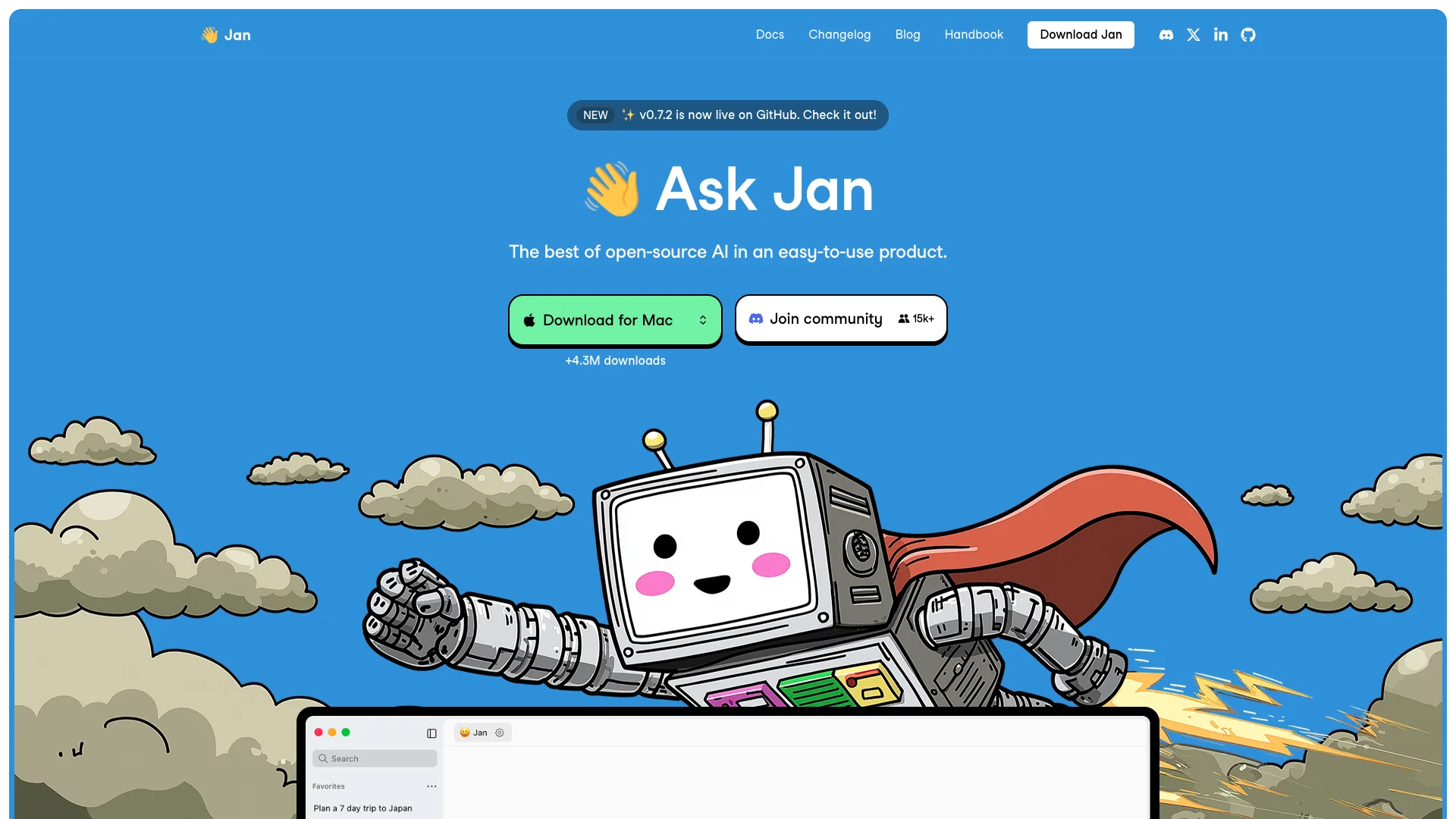
(Jan Website)
It’s available in a range of forms, including a desktop app, a web-based solution, or a self-hosted platform to run on your own infrastructure.
We have the option of running a local model or powering Jan with connections to major cloud-based providers, including OpenAI, Anthropic, Google, Meta, and more.
Jan also provides tools for creating and saving instructions to models, known as Assistants, enabling us to create reusable task-specific behavior.
If we utilize Jan Server, we can also access important enterprise functionality, including an OpenAI-compatible API, MCP support, multi-tenant architecture, performance monitoring, health checks, and more.
Overall, Jan is an impressive option for teams that want a direct open-source ChatGPT replacement. However, some other platforms may offer more advanced capabilities, including additional customization options or the ability to create callable workflow automations.
You might also like our round-up of the top open-source AI agent platforms .
6. LM Studio
Next, we have LM Studio. This is a platform for running, chatting with, and connecting tools to local models.
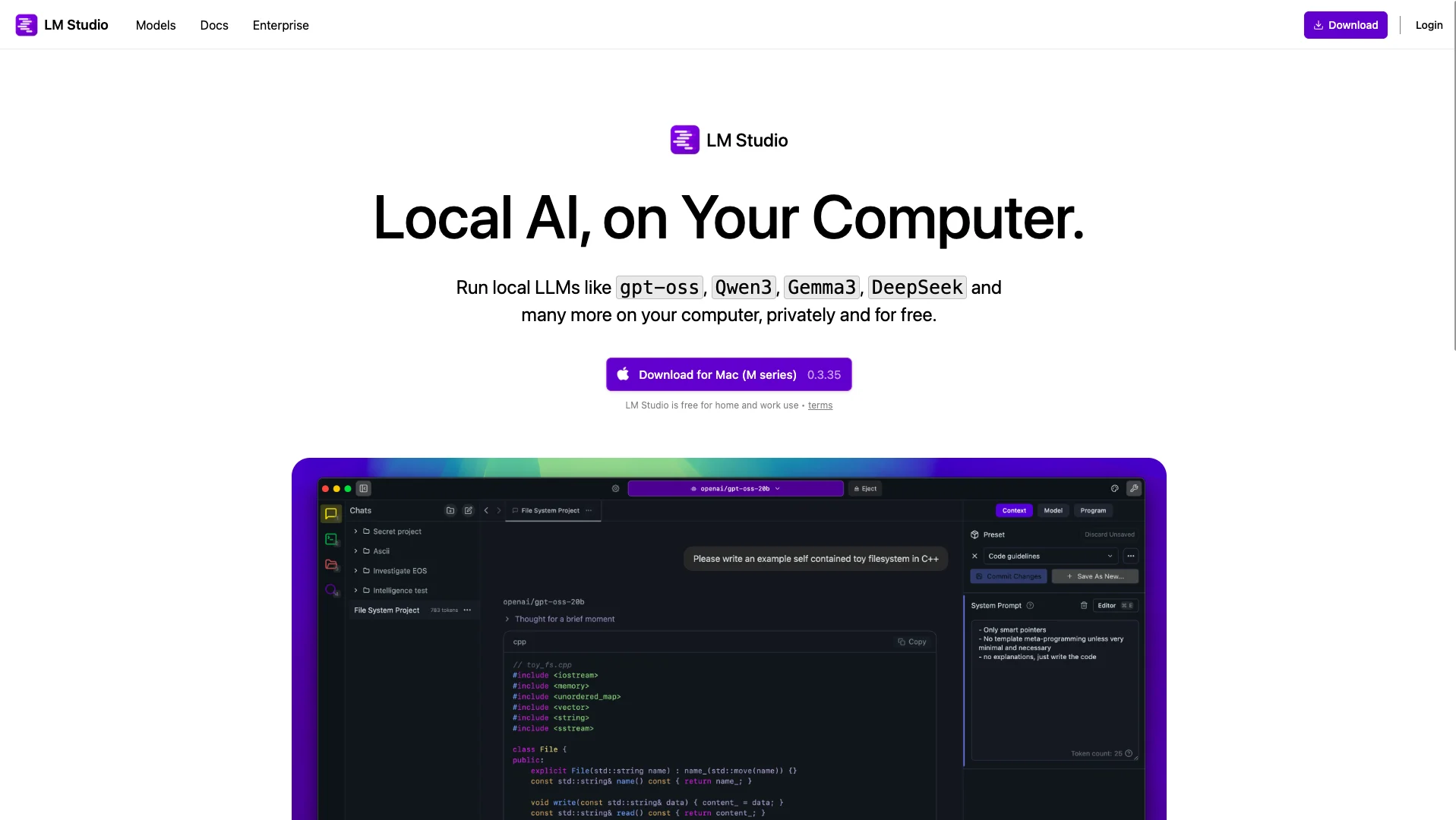 (LM Studio Website)
(LM Studio Website)
One of the real selling points of LM Studio is how quickly and easily we can get up and running. We simply need to download an LLM, load it into the application, and we can have back-and-forth conversations using the native chat UI.
We can also attach documents within chats, which LM Studio will either handle in-context or using RAG, depending on their size and the model we’re using’s supported context size.
The UI itself is highly funcitonal, including the ability to manage and duplicate chats using a drag-and-drop experience.
There’s also support for MCP, meaning we can make a wide range of tools callable by AI models.
Other helpful features include per-model default settings, speculative decoding, and prompt templates.
On the whole, LM Studio is a great option for users that want to run and interact with LLMs on their local machines, but we might want to consider other options for a more fully-featured solution for creating internal chatbots for business usage.
7. GPT4All
Part of the Nomic ecosystem, GPT4All is an open-source application for running AI chatbots with local LLMs.
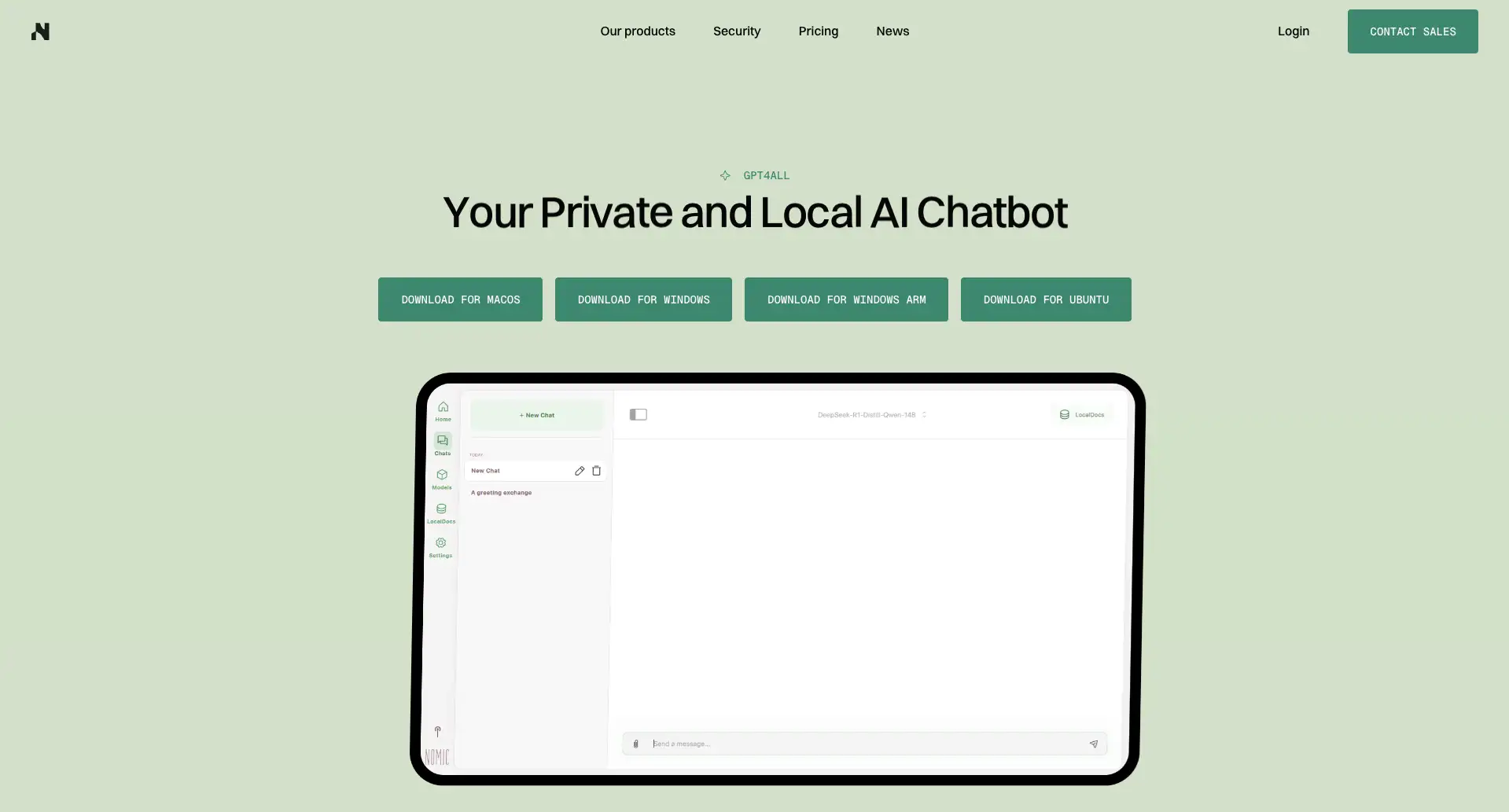
(GPT4All Website)
The goal is to empower developers and teams with the ability to run local models on everyday Windows, Mac, or Linux machines.
This includes a huge range of LLMs, with GPT4All specifically optimized to run models in the 3-13B parameter range.
One stand-out feature of this is LocalDocs. With this, we can easily create collections of files on our local machine, and vectorize them to be usable within chats.
The chat UI itself is intuitive and reasonably lightweight, meaning that it will likely be attractive to a range of users.
GPT4All also offers a high degree of customization. This includes a Python SDK and integration with OpenTelemetry, making it a flexible offering for more advanced use cases.
8. Open WebUI
Lastly, we have Open WebUI. This is perhaps the best-known self-hostable UI for AI chat, making it an important open-source ChatGPT alternative to be aware of.

(Open WebUI Website)
Open WebUI is hugely popular for offering an advanced, customizable front-end for working with local LLMs.
This centers around a modern, highly effective chat UI, with support for a wide variety of LLM runners and OpenAI-compatible APIs.
Open WebUI is also particularly well optimized for the needs of businesses that want to implement an internal chat solution, federated authentication, role-based access control, chat sharing, and more.
At the same time, it’s highly flexible tool for creating AI-powered workflows, including tool and function calling capabilities, as well as web search and in-chat code execution.
On the whole, it’s a hugely powerful platform that will appeal to a range of different kinds of users.
Turn data into action with Budibase
Budibase is the open-source, low-code platform that empowers IT teams to turn data into action.
With extensive data connectivity, autogenerated UIs, AI-powered automations, custom RBAC, optional self-hosting, and much more, there’s never been a better way to build secure, professional internal tools.
Check out our features overview to learn more.